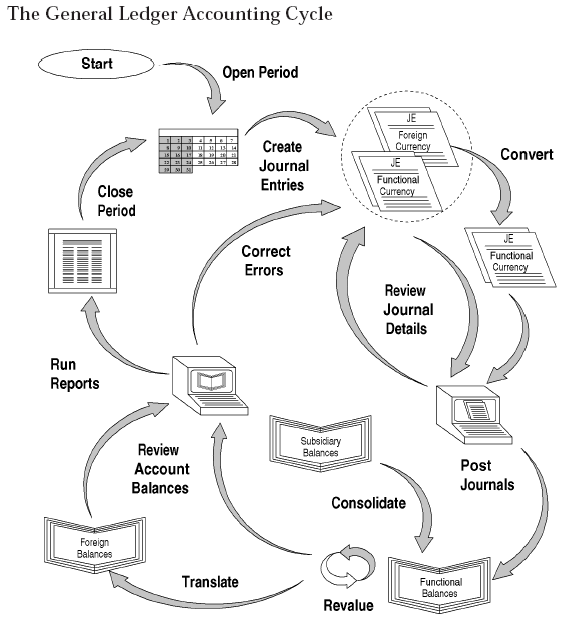FIFO and LIFO methods are accounting techniques used in managing inventory and financial matters involving the amount of money a company has tied up within inventory of produced goods, raw materials, parts, components, or feed stocks. These methods are used to manage assumptions of cost flows related to inventory, stock repurchases (if purchased at different prices), and various other accounting purposes.

Accounting Cycle
The accounting cycle (flows).
FIFO stands for first-in, first-out, meaning that the oldest inventory items recorded first are sold first, but does not necessarily mean that the exact oldest physical object has been tracked and sold.
- An example of how to calculate the ending inventory balance of the period using FIFO -- assume the following inventory is on hand and purchased on the following dates:
- Inventory of Product X -
- Purchase date: 10/1/12 -- 10 units at a cost of USD 5
- Purchase date: 10/5/12 -- 5 units at a cost of USD 6
- On 12/30/12, a sale of Product X is made for 11 units
- When the sale is made, it is assumed that the 10 units purchased on 10/1/12 (the sale eliminates this inventory layer) and 1 unit purchased on 10/5/12 were sold
- The ending inventory balance on 12/31/12, is 4 units at a cost of USD 6
LIFO stands for last-in, first-out, meaning that the most recently produced items are recorded as sold first. Since the 1970's, some U.S. companies shifted towards the use of LIFO, which reduces their income taxes in times of inflation. However, with International Financial Reporting Standards banning the use of LIFO, more companies have gone back to FIFO. LIFO is only used in Japan and the United States.
- An example of how to calculate the ending inventory balance of the period using LIFO -- assume the following inventory is on hand and purchased on the following dates:
- Inventory of Product X -
- Purchase date: 10/1/12 -- 10 units at a cost of USD 5
- Purchase date: 10/5/12 -- 5 units at a cost of USD 6
- On 12/30/12, a sale of Product X is made for 11 units
- When the sale is made, it is assumed that the 5 units purchased on 10/5/12 (the sale eliminates this inventory layer) and 6 units purchased on 10/1/12 were sold
- The ending inventory balance on 12/31/12, is 4 units at a cost of USD 5
Differences between Inventory Costing Methods
The difference between the cost of an inventory calculated under the FIFO and LIFO methods is called the LIFO reserve. This reserve is essentially the amount by which an entity's taxable income has been deferred by using the LIFO method.
Differences in Periods of Rising Prices (Inflation)
- FIFO (+) Higher value of inventory (-) Lower cost of goods sold
- LIFO (-) Lower value of inventory (+) Higher cost of goods sold
Differences in Periods of Falling Prices (Deflation)
- FIFO (-) Lower value of inventory (+) Higher cost of goods sold
- LIFO (+) Higher value on inventory (-) Lower cost on goods sold
Methods of Preparing Cash Flow Statements
- The direct method of preparing a cash flow statement results in report that is easier to understand. It creates a cash flow statement report using major classes of gross cash receipts and payments.
- The indirect method is almost universally used because FAS 95 requires a supplementary report similar to the indirect method if a company chooses to use the direct method. It uses net-income as a starting point, makes adjustments for all transactions for non-cash items, then adjusts from all cash-based transactions. An increase in an asset account is subtracted from net income. An increase in a liability account is added back to net income. This method converts accrual-basis net income (or loss) into cash flow by using a series of additions and deductions.